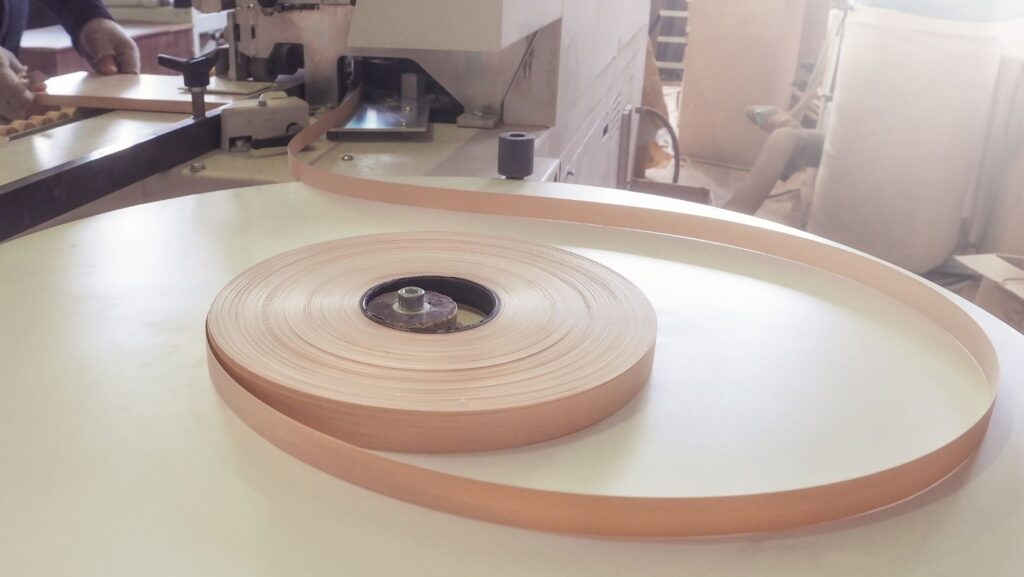
In the world of minimalist furniture design, every detail counts, and veneer edgebanding plays a pivotal role in achieving that coveted seamless look. By covering the raw edges of materials like plywood and MDF, veneer edgebanding offers a polished finish that enhances both durability and aesthetic appeal. This subtle yet effective technique ensures that minimalist furniture maintains its clean lines and visual harmony, which are central to the minimalist ethos.
Veneer edgebanding doesn’t just conceal imperfections; it elevates the design by allowing the use of cost-effective materials without sacrificing the natural elegance of wood. Designers can choose from a variety of woodgrain patterns and finishes, from light oak to dark walnut, to personalize each piece while staying true to minimalist principles. The result is furniture that is not only visually appealing but also practical and enduring, aligning with the minimalist value of creating timeless designs that withstand the test of time.
What is Veneer Edgebanding?
Veneer edgebanding is a thin wood veneer strip applied to the exposed edges of furniture panels made from materials like plywood, MDF, and particleboard. By covering raw edges, it offers both a seamless finish and enhanced durability, aligning well with minimalist furniture design. This technique maintains the natural wood appearance through a variety of wood species, grains, and finishes, allowing perfect matching with the surface material. Veneer edgebanding plays a crucial role in achieving the clean lines and visual harmony essential for minimalist aesthetics.
How Veneer Edgebanding Enhances Minimalist Design
Veneer edgebanding plays a crucial role in creating minimalist furniture designs, delivering a cohesive and sophisticated appearance that aligns with minimalist principles.
Seamless Aesthetics
Veneer edgebanding ensures a seamless aesthetic by covering raw edges, providing a polished finish that harmonizes with the minimalist style. It maintains clean lines and continuity, focusing attention on the furniture’s structure rather than distracting irregularities.
Lightweight Functionality
Minimalist designs frequently utilize lightweight materials such as MDF and plywood.

Veneer edgebanding conceals their industrial origins, offering a visually alluring finish that retains the practicality and cost-effectiveness of these materials without adding significant weight.
Customization in Woodgrain and Color
Veneer edge banding enhances customization options with a range of woodgrain patterns and colors. Designers can choose finishes from light oak to dark walnut, tailoring pieces to individual tastes while preserving the minimalist ethos. This versatility allows for personalized design without disrupting visual harmony.
Durability for Long-Lasting Simplicity
Durability is central to minimalist design, and veneer edgebanding fortifies furniture by protecting edges from wear and tear. It preserves pristine appearances, ensuring designs remain timeless and simple over years of use, aligning with minimalist values of functionality and longevity.
Eco-Friendly Options
Incorporating eco-friendly practices, veneer edgebanding uses thin wood strips, making efficient use of natural resources. This sustainable approach supports the minimalist principle of minimizing waste, offering an environmentally conscious alternative to synthetic materials.
Applications in Minimalist Furniture
Veneer edgebanding enhances minimalist furniture’s aesthetics by concealing raw edges. It becomes essential in open shelving, where exposed edges require finishing to ensure a polished look. By applying veneer edgebanding on plywood or MDF shelves, designers achieve clean lines aligned with minimalist principles.
Cabinetry benefits significantly from veneer edge banding. Minimalist designs focus on simplicity, often using flat-panel cabinets with smooth surfaces. Veneer edgebanding on these cabinets ensures a seamless appearance by hiding material joints that can disrupt visual harmony.
Tables and desks in workspaces also utilize veneer edgebanding. This technique creates sleek edges on tabletops made from composite materials. The seamless transition between surface and edge maintains the minimalist aesthetic, enhancing the furniture’s visual appeal.
Veneer edgebanding serves a crucial role in minimalist wardrobes and storage units. It ensures cohesive designs by covering exposed edges, offering durability without sacrificing style. Different wood species and finishes allow for customization, matching surfaces and edges perfectly.
Furniture for living areas, such as coffee tables and media consoles, uses veneer edge banding. It offers a finished look by hiding unsightly raw edges, maintaining the minimalist approach. The ability to choose from various wood grains adds versatility and sophistication to the designs.
Conclusion
Veneer edgebanding is undeniably a cornerstone in the creation of minimalist furniture designs. Its ability to transform raw materials into sleek, elegant pieces is unmatched, providing both aesthetic and functional benefits. By offering a seamless finish and enhancing durability, it aligns perfectly with the minimalist ethos of simplicity and sustainability. Designers and manufacturers can leverage its versatility to craft distinctive furniture that resonates with modern tastes while preserving the natural beauty of wood. As the demand for minimalist designs continues to grow, veneer edgebanding remains a vital technique, ensuring that furniture pieces are not only visually appealing but also built to last.













